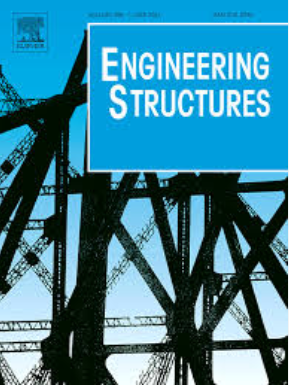Experimental study on global buckling behaviour of T-shaped box-T section beam- column
IF 5.6
1区 工程技术
Q1 ENGINEERING, CIVIL
引用次数: 0
Abstract
Due to the limitations of traditional column sections in high-rise buildings, such as occupying interior space, influencing floor layout, and reducing indoor aesthetics, irregularly shaped columns have gained increasing attention in both application and research. In this study, we introduced the concept of T-shaped box-T-section columns (T-BTSC) and performed full-scale testing on axial compression specimens in our first companion paper. To further provide a comprehensive understanding of this new column type, this research focused on the global buckling behavior of T-BTSCs under eccentric compression loads through an experimental approach. A total of sixteen full-scale specimens, constructed from 345 MPa steel, were tested, including both welded and hot-rolled sections. The failure modes, load–displacement curves, and buckling resistances of the specimens were thoroughly examined, and the validity of the plane section assumption was confirmed through strain measurements. A comparison between the experimental results and the design resistance predicted by the Chinese code GB 50017 was also performed, validating its applicability to T-BTSCs. Additionally, refined finite element models were developed and validated against the experimental data, facilitating further parametric studies and design optimization.
t形箱形截面梁柱整体屈曲行为试验研究
由于传统柱截面在高层建筑中的局限性,如占用室内空间、影响楼层布局、降低室内美观等,不规则形状柱在应用和研究中越来越受到重视。在这项研究中,我们引入了t形箱形t截面柱(T-BTSC)的概念,并在我们的第一篇论文中对轴压试件进行了全尺寸测试。为了进一步全面了解这种新型柱型,本研究通过实验方法研究了T-BTSCs在偏心压缩载荷作用下的整体屈曲行为。共有16个全尺寸试样,由345 MPa钢建造,进行了测试,包括焊接和热轧部分。对试件的破坏模式、荷载-位移曲线和抗屈曲能力进行了深入研究,并通过应变测量验证了平面截面假设的有效性。将试验结果与GB 50017规范预测的设计阻力进行了比较,验证了其对T-BTSCs的适用性。此外,根据实验数据建立了精细化的有限元模型并进行了验证,为进一步的参数化研究和设计优化提供了便利。
本文章由计算机程序翻译,如有差异,请以英文原文为准。
求助全文
约1分钟内获得全文
求助全文
来源期刊

Engineering Structures
工程技术-工程:土木
CiteScore
10.20
自引率
14.50%
发文量
1385
审稿时长
67 days
期刊介绍:
Engineering Structures provides a forum for a broad blend of scientific and technical papers to reflect the evolving needs of the structural engineering and structural mechanics communities. Particularly welcome are contributions dealing with applications of structural engineering and mechanics principles in all areas of technology. The journal aspires to a broad and integrated coverage of the effects of dynamic loadings and of the modelling techniques whereby the structural response to these loadings may be computed.
The scope of Engineering Structures encompasses, but is not restricted to, the following areas: infrastructure engineering; earthquake engineering; structure-fluid-soil interaction; wind engineering; fire engineering; blast engineering; structural reliability/stability; life assessment/integrity; structural health monitoring; multi-hazard engineering; structural dynamics; optimization; expert systems; experimental modelling; performance-based design; multiscale analysis; value engineering.
Topics of interest include: tall buildings; innovative structures; environmentally responsive structures; bridges; stadiums; commercial and public buildings; transmission towers; television and telecommunication masts; foldable structures; cooling towers; plates and shells; suspension structures; protective structures; smart structures; nuclear reactors; dams; pressure vessels; pipelines; tunnels.
Engineering Structures also publishes review articles, short communications and discussions, book reviews, and a diary on international events related to any aspect of structural engineering.
 求助内容:
求助内容: 应助结果提醒方式:
应助结果提醒方式:


